
The first in an exciting new series, Ken Kempa will be taking an up-to-date look at the popular metric cartridges. Using the newest bullets and powders from around the world, each article will be a definitive reference for shooters and hunters- who already have these cartridges- or for those who may be swayed into getting one.
I have long heard about the 8×57 cartridge, but in the US, most metric rounds do not get a lot of field exposure, or even print in magazines. The basic reason is that our manufacturers have lawyers that fear someone putting modern ammo into an old military surplus rifle. As such, US loaded 8×57 ammunition is just barely more powerful than the old .30-30. That does not make a good old boy from the deep South want to run out and get one, much less a 7×64, 6.5×55, or even a 9,3×62. Most shooters in the US would do a “say what?!?!” at the mere mention of any of these popular metric rounds.
To me though, as long as I have brass, bullets, and dies, a gun is a gun. I saw the Magic Metrics series as a chance for me to learn a lot about cartridges I had only heard about but not worked with. Since they work so well in Europe for millions of shooters and hunters, I was determined to approach the series with an open mind. Actually, I am really looking forward to all of the work; and work it will be. I am committing to making each one of these articles be the definitive last word for each cartridge to be covered.
If you already have one, you will learn a lot about their capabilities. If you do not have one, then I hope my efforts will enlighten you on what you may be missing out. A broad range of bullets and powders will be tested. In most cases, not a few dozen combinations, but upwards of six to eight dozen bullet and powder variations will be loaded and tested for accuracy and power.
Chapter 1: The Cartridge and Rifle
Click for LOAD DATA SHEET
The 8×57 is a medium bore cartridge with a moderate case capacity relative to the bore size. It falls neatly between the 308 Winchester and the .30-06 as far as water capacity, placing it in the friendly to shoot category. That also means, to me, that it probably will not hit blistering speeds, or shoot as flat as a laser. That is just fine. Since most game taken...
in the world is shot at close to moderate ranges, there is no need for cartridges burning 70 or more grains of powder. It also means that it will have reasonable recoil levels, even with top loads. It will not consume a canister of powder in the blink of an eye or require super premium bullets to keep from having performance failures during a hunt
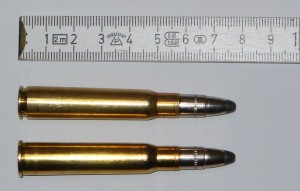
You can load four or five into a magazine instead of the only three rounds of the belted or short magnums. I can easily shoot a 308 or a 30-06, so I looked forward to not getting beat up when shooting the over 900 rounds I would assemble for the testing. Moderate recoil levels translate into better shooter accuracy on paper and in the field. It should be able to handle light or medium game as well as either of the two 30 calibers, and due to greater bore size, perhaps perform even better with heavier bullets on large and heavy game. I am beginning to like the 8×57 already!
For my testing, I used a Steyr ProHunter with a 23.6” barrel. In part because every one I have worked with shot very well to extremely well during load development. Why spend hours and hours at the bench and then at the range, only to be rewarded with 2 inch or larger groups? With the time invested in loading and shooting so many rounds, I wanted to get a head start by using a manufacturer with a history of producing accurate rifles. A Leupold VX-III 6-18 target scope was mounted using their Quick Release Weaver style bases and rings (QRW), so that when finished with my tests, a more traditional 3-9 scope could easily be installed. It is also a great help to not have to keep going back and forth from the rifle to a spotting scope when shooting so many groups. The Leupold scope saved me lots of time at the range as bullet holes could easily be seen.
I cleaned every 20 shots or so using Barnes CR-10 and a stiff brass brush followed by dry patches until they came out clean. Temperatures in the early spring testing were very similar to fall hunting weather, so velocities should also be in line.
...
Chapter 2: Reloading Components Tested
I worked with eighteen bullets and eleven powders during my trials. If I had a new 8×57 rifle to take elk hunting in the deep woods, then I could have just tried a bullet or two.
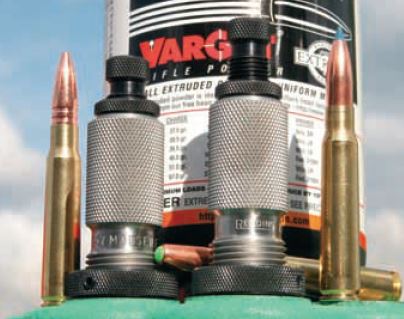
But as I desire for the Magic Metric series to be the definitive reference for metric shooters, I pretty much tried every bullet I could get my hands on. Light to heavy, the list included: 125-grain, 150, 170 and 195-grain Hornadys; 180-grain bullets from Lapua- Naturalis, Norma- Oryx, Nosler- Ballistic Tip, Barnes- TSX (Triple Shock X-Bullets), and the 181-grain RWS Doppelkern; the 198-grain classic RWS TIG; 200-grain bullets from Barnes- the TSX and discontinued XLC; Nosler Partitions and the new AccuBond style; from Australia, the Woodleigh 220-grain WeldCore RN SPs (with bonded cores of pure lead); Barnes 220-grain solids for heavy African game; the 224-grain RWS Kegelspitz; and finally, the heavy 250-grain Woodleigh WeldCore RN SPs. The eleven powders included: from Accurate Arms- 5744 for reduced loads, 2015, 2495, 2520, 4064 and 4350; from Hodgdon- Varget, H4895, H380, H414, and H4350. I am tired already!
Exclusively, Federal 210M, Large Rifle Match primers were used. I only had access to Remington brass and was very happy with its performance. I had also hoped to use some RWS brass, but none was available. All ammunition was loaded using Redding dies on their T-7 Turret reloading press. Having both dies readily available for use was a great timesaver. After four or five loadings, the brass was trimmed using their #1400 case trimmer- it worked just like a small lathe, giving me uniform brass lengths in no time at all.
Cases were lubricated with Redding’s Imperial Sizing Die Wax; I have used that product for over twenty-five years and love how well it works. The RCBS ChargeMaster combined electronic powder dispenser and scale was a huge time saver. It made assembling the almost one-hundred load combinations so much less of a chore- I would never be without mine again.
Chapter 3: Results and Recommendations
For great reduced recoil practice loads that would...
also be good for hunting light game, three Hornady bullets proved to work very well- their 125 and 150-grain pointed soft points, and the round nosed 170-grain bullet. Very light charges in the mid-thirties range posted speeds of 2,300 to 2,600 fps. Recoil, muzzle blast, and barrel heating were vastly reduced compared to full-power loads. Young shooters, small framed women, or recoil intolerant shooters can practice away with these loads, and yet still take light game with them. Any of the six loads developed with these bullets were plenty accurate for off season practice, with the 170-grain round nose slugs shooting into only 0.61”. The rifle goes “pop,” and bullet after bullet lands within less than 3/8” from your aiming point. These loads are fun! There is no need to pound your shoulder or your ears when you can almost caress them instead.
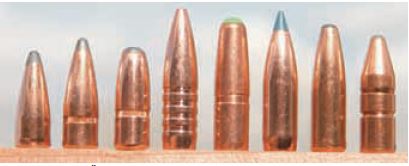
With the Hornady 150-grain soft point, changing to Accurate 2520 powder, I was able to obtain over 3,000 fps with very good accuracy. This would make a great mountain or open plains hunting load for pronghorn antelope or deer. The 170-grain bullet shot extremely well with 0.59 or 0.63” groups, using Accurate 2015 or Hodgdon Varget.
The Norma Oryx, a bonded core bullet, also proved to be very accurate. For the hunter, that is a combination that is hard to beat. Both Accurate 2015 and 4064 powders would punch out very, very nice groups of less than 3/8” when loaded under the Oryx. While almost having a round tip, the profile is very slender, making it far more than a close range projectile. A hunter would be well armed with this bullet.
The Norma Oryx is a bonded core bullet, which also proved to be very accurate. For the hunter, that is a combination that is hard to beat. Both Accurate 2015 and 4064 powders would punch out very, very nice groups of less than 3/8” when loaded under the Oryx. While almost having a round tip, the profile is very slender, making it far more than a close range projectile. A hunter would be well armed with this bullet.
Fast and racy looking, even when just sitting still, best describes the Nosler Ballistic Tip. It has a boattail configuration and a sleek, steel-blue, pointy plastic...
tip to fly straight and hit hard. Ballistic Tips have always shot accurately for me in many rifles and calibers, with the 8mm version being no exception. Both the lightest load with 2015, or the heaviest using Hodgdon Varget, shot very well at 0.63” and 0.55” respectively. While I would not try to shoot diagonally through an elk with this bullet out to 300 yards or so, a broadside hit would result in a very swift and sudden demise.
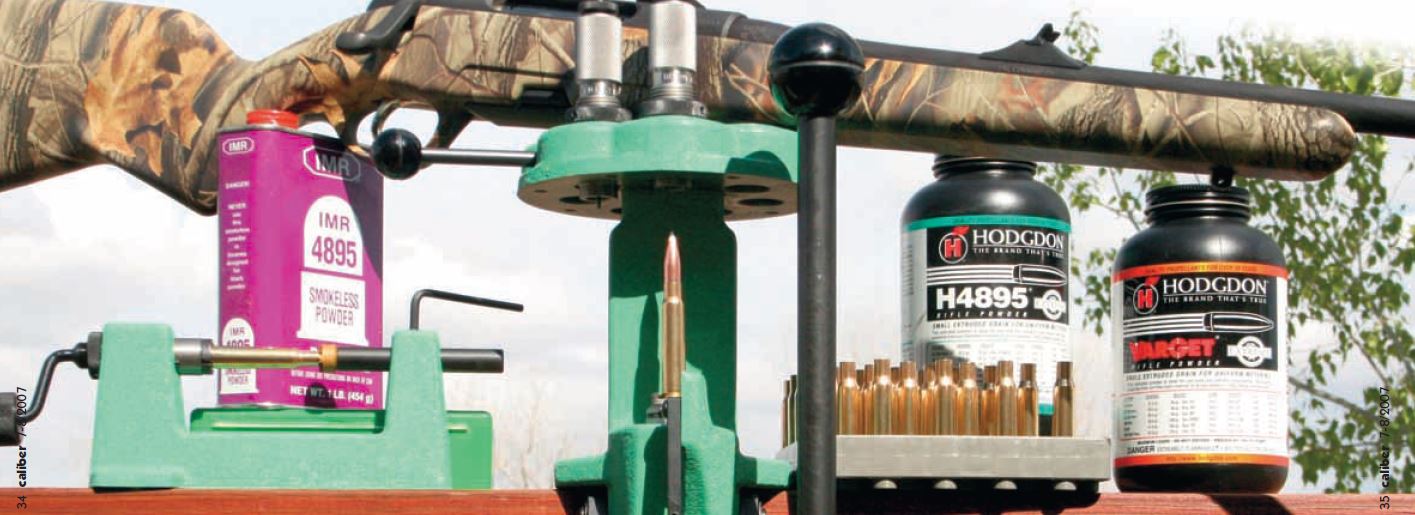
Also great looking, the Barnes 180-grain TSX additionally offers enhanced penetration capabilities while reducing meat damage due to bloodshot. From experiences I had with a similar 175-grain X-Bullet in .338 while living in Montana, I would expect the 8mm TSX to shoot through most game, even on quartering shots. Accurate 2520 powder shot very fast and resulted in nice looking 0.67” groups. Totally new to me was the 181-grain RWS Doppelkern, or “double core.” The front portion is designed to break up early in the animal, to impart great damage and shock to the organs, while the rear section continues on for probable full penetration and the resultant exit wound. 2495 powder from Accurate gave speeds of 2,562 fps, with 0.87” groups.
For fear of having hotter 8×75 ammo being fired in the earlier 8x57IJ rifles, which required .318 diameter bullets, American ammo is downloaded to just above .30-30 velocities. While I had no desire to test any of that, Hornady was happy to have me test their 195-grain factory load. Do not like to handload? If so, there is no need to look any further than this round. Good speeds of 2,417 fps resulted in very consistent groups, averaging only 0.67”- pretty impressive for factory ammo from a production rifle. Some of my better reloads approached the Hornady factory ammunition accuracy, but those had to be found after much trial and error. If you would rather have more time to hunt rather than sitting at a bench, just grab a box or two and head to the field. Its weight and construction make it great for deer, hogs, elk, black bear or moose, either up close or farther out to medium ranges.
...
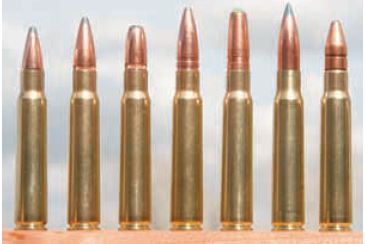
Accustomed to sleek, sexy, plastic tipped pointy bullets, I sort of went “Huh?” when I opened the box of RWS TIG bullets. I had heard of them, but I had never seen one. Now I know better. I have found that they shoot very well and have a rear portion that can penetrate deeply after having shed the front half early on when penetrating the animal. I am looking forward to taking some game with them as soon as I get the chance. They always provided nice round groups from the Steyr, and cut very clean holes on target.
Four 200-grain bullets were tested in the 8×57. At this weight threshold, we are getting into medium and heavy game projectiles. First, the Barnes TSX- shot very well with all six powders tried, and really great with three of them producing groups in the 0.55 to 0.67” range. Hodgdon’s Varget and H414 were the winners, as well as Accurate 2520. Sadly, an incredible finding in the accuracy department was the discontinued 200-grain Barnes blue XLC bullet. I only tried two powders with it; both were outstanding- Hodgdon H380, and Accurate 2520. Testing produced 0.28 and 0.39” back-to-back groups from the Steyr!
The classic Nosler Partition in 200-grains looks great and shoots well enough to even please a particular shooter. With five powders, I got average 3-shot groups of 0.39 to 0.98” at 100 yards. It does not seem at all particular about what powder you put under it. Providing fast expansion and deep penetration, it may be the bullet of choice if load development time is limited. The Partition is a very handloader and hunter friendly bullet for the 8×57. The very new AccuBond shot extremely well using H414 powder. It is more aerodynamic than the Partition, and the core is bonded to the jacket for high weight retention and deeper penetration. It most certainly is one of the best looking bullets around, and there is nothing at all wrong with that!
It is late in the day, getting very dark, and you need to hit a hog, elk or black bear real hard. You might be very well served with the Woodleigh WeldCore bullets for your 8×57 in either the 220 or 250-grain weights. The name comes from the fact that...
the cores are soldered to the very ductile jackets. Moderate expansion, coupled with high weight retention, will result in deep penetration when used on heavy game. My Steyr really liked the 220s, with three powders producing groups in the 0.80” size. H380 approached the accuracy and speed of the Hornady factory load, but delivers an extra 25-grains on target. The 250s would be great on game, moose-sized and larger. Too late to obtain samples for testing, Woodleigh of Australia is also now making a more aerodynamic and sleek protected point bullet in 200 and 220-grains.

I still had some solids on my shelves which I bought “just because”. Made by Barnes in 220-grain round nose configuration (but now discontinued), they are meant for extremely deep penetration on thick skinned, heavy, dangerous game. Perhaps you can still find some? A few solids are always nice to carry when hunting in Africa. I tried four powders with these bullets. Three shot into 0.83 to 0.91”; while H380 amazingly grouped into 0.55”! That is a real fun load to shoot, knowing that the holes you make will be so close together.
Lastly, the RWS 224-grain Kegelspitz bullet reached around 2,300 fps on either H380 or H414, shooting into 0.83 and 0.98” respectively. As I only had a few of them for testing, I could not afford to try more powder types. It should be a great bullet for woods hunting of medium or large game.
Chapter 4: Summary
There are definite advantages to being a medium bore cartridge of moderate capacity. The 8×57 was found to be versatile and very accurate with a broad variety of loads using a wide range of hunting bullets from 125 to 250-grains. As it only consumes powder charges from the mid-forties to the low-fifties, it is easy on a can of powder and on your shoulder. Is that important, and does it really matter? I do think so. I found it to be quite easy to assemble a very large number of accurate loads, shooting under one inch or less, with many doing around a half inch or even less.
The Steyr is “only” a hunting rifle, but a very well behaved one at that. I found I could shoot several hundred rounds from the bench at a time and not even...
be a little sore. A hunter who is not afraid of his weapon can accurately shoot it at the bench, or in the field when the importance of good shooting is paramount. Though falling between the 308 and the 30-06 in capacity, I believe it out performs them both. It has proven capable of being loaded up, or loaded down. I do love the bigger hole in the muzzle because, for me, that suggests more power. True or not, what a hunter believes is what probably will work best for him. I am looking forward to hunting soon with this 8×57 rifle. It does not beat me up, it does not have an atomic muzzle blast, and with great bullets and good loads, it gives me great confidence as it produces very tiny groups.
While it is not as flat shooting as a magnum at extended ranges, the vast majority of my game I have taken the past thirty years has been at ranges of 250 yards or less, more often than not. As I reach the half century mark, I finally am not afraid to admit to needing and liking just enough gun. After over nine-hundred rounds, I truly do believe the 8×57, with great bullets and loads, is enough gun for most hunters, for most situations.